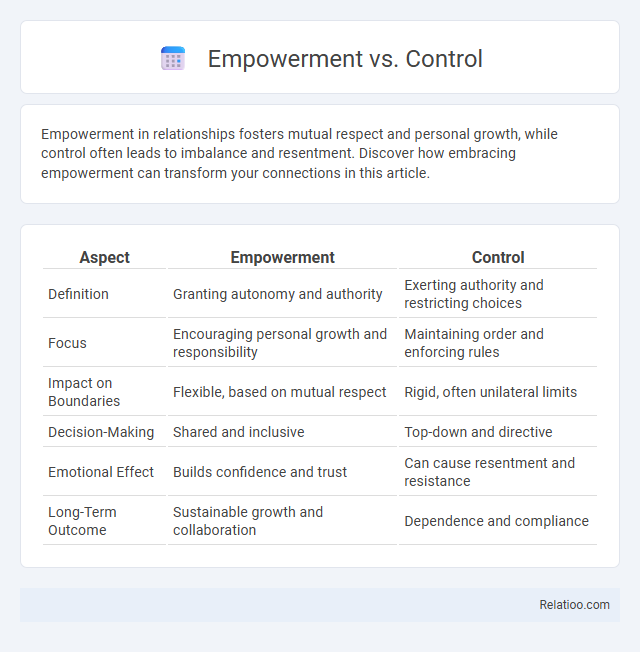Empowerment in relationships fosters mutual respect and personal growth, while control often leads to imbalance and resentment. Discover how embracing empowerment can transform your connections in this article.
Table of Comparison
| Aspect | Empowerment | Control |
|---|---|---|
| Definition | Granting autonomy and authority | Exerting authority and restricting choices |
| Focus | Encouraging personal growth and responsibility | Maintaining order and enforcing rules |
| Impact on Boundaries | Flexible, based on mutual respect | Rigid, often unilateral limits |
| Decision-Making | Shared and inclusive | Top-down and directive |
| Emotional Effect | Builds confidence and trust | Can cause resentment and resistance |
| Long-Term Outcome | Sustainable growth and collaboration | Dependence and compliance |
Understanding Empowerment and Control
Understanding empowerment involves recognizing how it fosters autonomy by enabling individuals to make decisions and take responsibility, enhancing motivation and performance. Control typically restricts freedom by imposing rules and oversight, which can limit creativity but ensures consistency and compliance. Balancing your approach between empowerment and control optimizes organizational effectiveness and promotes personal growth.
Key Differences Between Empowerment and Control
Empowerment centers on granting individuals autonomy and the authority to make decisions, fostering motivation and innovation, whereas control involves enforcing strict guidelines and monitoring to ensure compliance and uniformity. Key differences lie in the level of trust and freedom provided: empowerment encourages initiative and personal responsibility, while control relies on oversight and regulation. Organizations that emphasize empowerment tend to experience higher employee engagement and adaptability compared to those prioritizing control.
The Psychology Behind Empowerment
The psychology behind empowerment highlights intrinsic motivation and self-efficacy as key drivers for effective performance and well-being. Unlike control, which relies on external regulation and can diminish autonomy, empowerment fosters a sense of ownership and competence, enhancing engagement and resilience. Research shows empowered individuals experience higher satisfaction and creativity, as their cognitive and emotional needs for autonomy and mastery are met.
The Impact of Control on Individuals
Excessive control in organizational settings often diminishes individual autonomy, leading to reduced motivation and creativity. Research indicates that tightly controlled environments can increase stress levels and decrease job satisfaction, ultimately impairing overall performance. Empowerment, contrasted with control, fosters a sense of ownership and engagement, which positively influences productivity and well-being.
Benefits of Empowerment in the Workplace
Empowerment in the workplace enhances employee engagement by fostering autonomy and encouraging innovation, leading to higher productivity and job satisfaction. Unlike traditional control methods that limit creativity, empowerment cultivates trust and accountability, which drives motivation and organizational commitment. Research shows empowered teams experience lower turnover rates and improved problem-solving capabilities, resulting in sustainable business growth.
Risks and Consequences of Excessive Control
Excessive control in organizational settings often leads to diminished employee empowerment, resulting in decreased motivation, creativity, and job satisfaction. Overbearing control mechanisms increase the risk of resistance, burnout, and high turnover rates, impairing overall productivity. Long-term reliance on strict control fosters a toxic work environment that stifles innovation and erodes trust between management and staff.
Empowerment vs Control in Leadership Styles
Empowerment in leadership fosters autonomy by encouraging decision-making and innovation among team members, enhancing motivation and performance. Control-based leadership, in contrast, relies on strict oversight and directive management, which can limit creativity but ensure consistency and compliance. Effective leaders balance empowerment and control to align team autonomy with organizational goals, optimizing productivity and engagement.
How to Foster an Empowering Environment
To foster an empowering environment, prioritize creating spaces where Your team feels trusted and valued, encouraging autonomy and innovation. Shift from rigid control mechanisms to supportive leadership that promotes open communication and shared decision-making. Empowerment thrives when individuals are given clear goals, resources, and the confidence to take initiative within a framework of accountability.
Striking the Right Balance: Empowerment and Control
Striking the right balance between empowerment and control is crucial for fostering a productive work environment where individuals feel trusted yet guided. Empowerment encourages innovation and accountability by giving Your team the autonomy to make decisions, while control ensures alignment with organizational goals and mitigates risks. By strategically combining these elements, businesses create a framework that boosts motivation and maintains operational consistency.
Real-World Examples: Empowerment vs Control
Empowerment in the workplace often leads to higher employee engagement and innovation, as seen in companies like Google, where team members are encouraged to take ownership of projects and make decisions independently. In contrast, organizations that focus on strict control, such as traditional manufacturing firms, may experience efficiency but often at the expense of creativity and employee satisfaction. Your challenge lies in balancing empowerment and control to foster a motivated workforce while maintaining organizational standards.

Infographic: Empowerment vs Control
 relatioo.com
relatioo.com